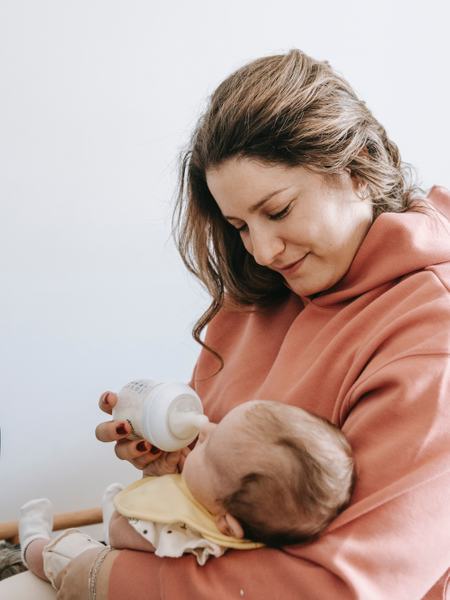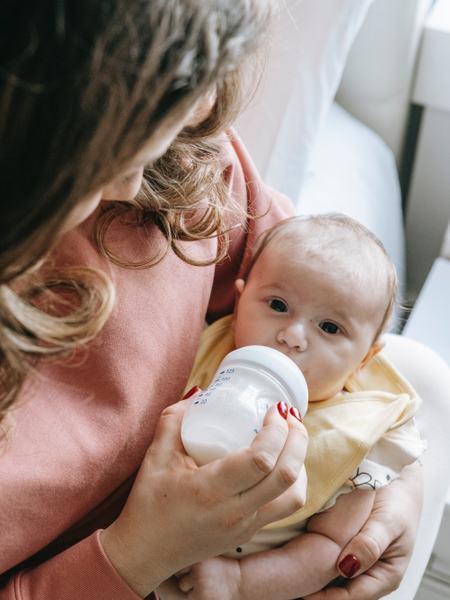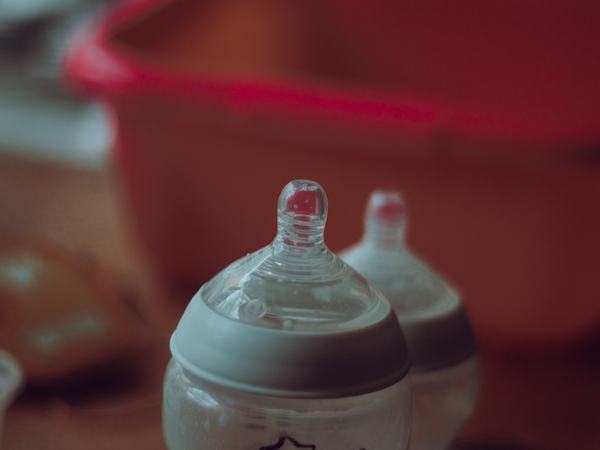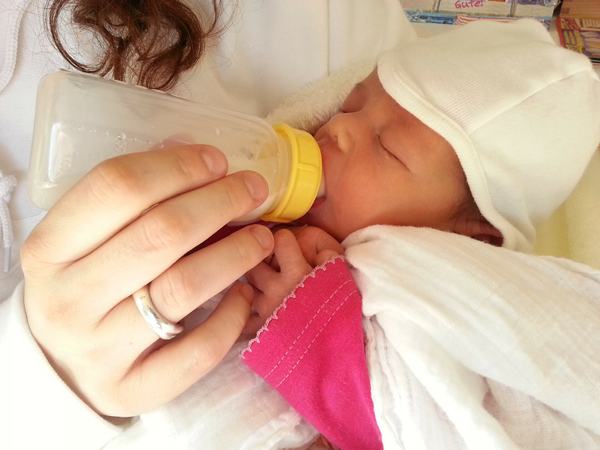How to bottle feed your baby according to your needs
Parents are constantly encountering the opinions of others. Opinions are voiced about sleep patterns, certain rhythms and rituals, and even the form of feeding. When parents bottle-feed their baby, they often encounter very different statements such as "Why isn't the baby breastfed?" or "This way, daddy can finally take over and participate, too." Often there are also accusations that bottle-feeding is less good for the child and that the bond with the child would suffer under bottle-feeding.
I think everyone is now aware that breast milk is the optimal food for babies. It is perfectly adapted to the needs, age and stage of development. At the same time, the reasons for not breastfeeding or not exclusively breastfeeding are very diverse. There are women who do not want to breastfeed. There are women who have tried to breastfeed and have had to give up after various problems and lack of support. And there are women who want freedom and independence and do not want to give up breastfeeding completely.
Whenever breastfeeding is still going on in parallel and there is a desire to breastfeed, another (complementary) feeding option than the bottle should be used if possible. It is not uncommon for there to be suction confusion here, although of course this cannot be predicted with certainty. Breastfeeding-friendly complementary feeding methods are the breastfeeding set ( BES for short) or feeding with a cup, which can also work with newborns.
I think it's wrong to judge parents. Especially in this case, when it comes to bottle feeding. Bottle feeding can be just as need-based. When we think about what we should pay attention to, it's worth taking a look at breastfeeding, because breastfeeding can serve as a model for us in this regard. Breastfeeding fulfills many more needs than simply providing nourishment. These other needs, such as providing security and closeness, can also be met when bottle feeding.
If you are breastfeeding or have breastfed, many aspects will certainly sound familiar to you. I would like to give you concrete suggestions on how you can design the feeding situation, what you can pay attention to and why these factors are significant.
Summary
1. pay attention to your baby's signals
You can also go by your baby's needs when bottle feeding. It makes little sense to keep rigid intervals, a certain number of meals and the feeding amount the same at all meals without orienting yourself to your baby. The manufacturer's instructions on the powder packaging are therefore often misleading and do not match the amounts and/or the rhythm of your baby.
Your baby will signal to you when he is hungry. He will become more active, turn his head and make searching movements, smacking sounds and suck on your hand, for example. These are all possible signs of hunger in the first weeks of life. Later, sucking on the hand, for example, is no longer a classic hunger sign. If your baby really cries and screams because of hunger, this is a very late sign of hunger. If possible, you should make sure that you prepare the bottle when your baby shows the first small signs of hunger.
However, it is not only the start and interval of meals that you can follow. Your baby also gives you signals during mealtimes that you can watch out for. He or she may drink very hastily, choke and/or have trouble breathing. In this case, it is a good idea to take a break and check your baby's posture again. I will come to this in more detail later. You can take the bottle out of your mouth and hold it to your chin, for example, so that your baby knows that the bottle is still there. Alternatively, you can put it on your shoulder if maybe you feel like he needs to burp.
As for the beginning of the meal, it is important to mention that you should wait until your baby opens his mouth really wide before you put the bottle in his mouth. To do this, you can run the teat a little along the upper lip. Most children open their mouths when you do this. When the mouth is open, give the bottle quickly into the mouth.

If your baby turns his head away, falls asleep or becomes visibly restless, he may be full, or he may just want a short break. If he doesn't open his mouth and doesn't want to put the bottle in his mouth, he's probably not hungry anymore. Even if there is still some milk in the bottle, you should not force your baby to continue drinking. However, I am writing in this article exclusively about healthy children with sufficient weight gain. In exceptional cases, you may need to feed differently.

If you notice that you are very tense when you feed your baby because you keep looking at the amount of milk in the bottle, then a simple trick comes in handy. You can simply put a sock of yours over the bottle so that you can't see how much milk is left in the bottle. You will probably be able to concentrate better on your baby and his signals.
2 Switch sides when bottle feeding
When bottle feeding, we tend to always feed the baby in one position, on one side. In breastfeeding, this choice does not arise because the vast majority of breastfeeding women nurse both breasts. It also makes sense to switch sides when bottle feeding.
This may feel a little strange at first, but you will get used to it. For your baby, by the way, this may also be unusual at first, but your baby will get used to it, too.
When both sides are fed, the muscles and perception are stimulated more evenly. Stimuli come sometimes from one side and sometimes from the other. To develop the muscles even more, you can always hold your baby against the bottle when he or she is sucking. This will make him suck even harder. However, you should not pull so hard that your baby cannot keep the bottle in his mouth or slips off again and again.
Changing sides is a good idea, by the way, if your baby takes a break in between bottle feedings anyway. So if you put him on your shoulder to burp him, you can continue feeding him on the other side. 3.
3. keep your baby close and safe
Your baby should always feel held close and secure while feeding. It should be stable, and the head and body should be adequately supported. If the position is not sufficiently stable, your baby will have to work very hard muscularly, may be strained and distracted to even stay in a good position or get there.
In addition, holding the bottle may then be more strenuous, which is why your baby cannot suck in a relaxed manner. This additionally creates a less than optimal sucking pattern because your baby will likely have to build up more pressure through their lips and tongue, which can make the whole feeding cramped and ineffective.
So make sure that you hold your baby really stable and possibly additionally support it with pillows so that it can't slip away.

An upright position is ideal for this, because it also makes it easier for your baby to expel and regurgitate any air that may be swallowed.

4. feed in a position that is comfortable for you
For example, if you feed at every meal without any support from pillows or armrests or the like, your muscles will eventually become exhausted - especially if the meals are long and your baby is getting progressively heavier. When your arm is exhausted, it's likely to slide a little lower, making your baby work harder, which, as I described above, is inconvenient.
Consequently, it's important for you to make sure you're in a comfortable, stable position as well. Anything you need to hold, such as your arm, you can support well with pillows or an armrest (at a suitable height).
You can also take the strain off your lower back by placing your feet on a stool while feeding.
You will spend a lot of time feeding, especially in the first weeks after birth. It is therefore important that you are not in pain or uncomfortable in any way. It is best to create a good and comfortable feeding place before your baby gets very hungry. This way you can enjoy the time with your baby better.
In addition, your baby senses exactly when you are tense, because it may not be really comfortable for you. He mirrors you and is also tense. His restlessness in turn makes you more tense and stressed, creating a vicious cycle.
5. Give your baby skin-to-skin contact when feeding.
When we look at what is important for bonding with our baby, we quickly encounter the hormone oxytocin. Oxytocin is the hormone that is also called the cuddle or love hormone. It is secreted when we feel comfortable and when we are in direct physical or even better skin contact with each other.
For babies, skin contact is particularly important, as I described in more detail in my article Babies need body contact and closeness. In summary, however, skin contact has a whole range of positive effects on very different levels - organically, psycho-emotionally, in terms of self-awareness, communication and even your baby's sleep.

When bottle feeding, you probably rarely have direct skin-to-skin contact with your baby. You could make sure that you enjoy at least some skin contact every now and then when feeding your baby. Of course, both of you should be warm enough to do this. Your partner can also feed regularly in skin-to-skin contact.
6. choose a suitable teat
The choice of teat is also important for need-based bottle feeding. However, I will only touch on this topic briefly here.

Overall, you can also base your choice of teat on the model of the breast (nipple). The teat should have a round, long shape, should be as soft as possible and therefore movable and malleable. The teat should offer a wide contact surface so that your baby has to open its mouth really wide. It also makes sense if the surface offers some structure, so the teat is at least partially somewhat milky. This way, the structure resembles the skin more.
Regarding the hole size, it is advisable to always feed with the teat with the smallest hole. When you turn the filled bottle upside down, there should be at least one drop per second. This is the only way that your baby really has to work when drinking and does not simply let the milk run into the mouth.
In some situations, the choice of teat may be different - for example, if there is a cleft lip and palate or if your baby is premature and still very small. All in all, of course, the individual needs of your baby should be taken into account.

A small final note and conclusion
All the bottle feeding tips I have described here apply to healthy babies with sufficient weight gain. Sick babies or babies with failure to thrive may need to be fed differently.
What is not mentioned, which should also go without saying, is that you should not leave your baby alone with the bottle. Your baby should always be fed directly with you.
As you have seen, you can implement a whole range of aspects in bottle feeding to make the feeding situation need-based. This concerns the rhythm of the meals, the position at feeding, the choice of teat and much more.
I hope you were able to take something away from this article. If you have any questions or comments, feel free to drop me a comment below this article!
Image sources
- Cover image: www.pexels.com
- Image 1: www.pexels.com
- Image 2: www.pexels.com
- Image 3: www.pexels.com
- Image 4: www.pexels.com
- Image 5: unsplash.com
- Image 6: unsplash.com
- Image 7: pixabay.com
No comments yet.